Take the pressure down! Six ways to care for your pelvic floor while you workout
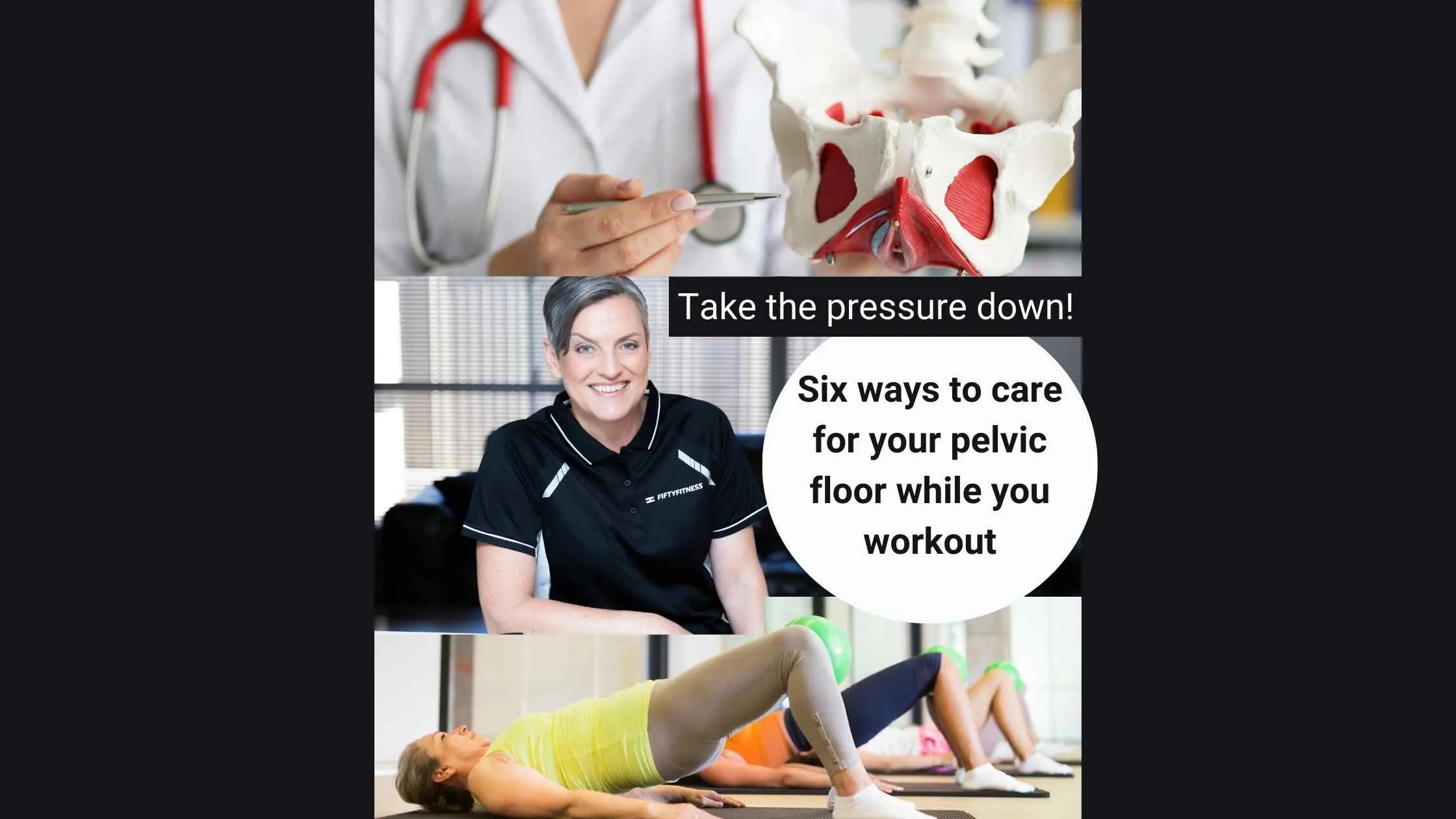
Dilemma
The final point in my previous article was that exercise is one of several factors that can increase intra-abdominal pressure, which puts pressure on our pelvic floor muscles.
This presents us with a dilemma because it’s vital for us to exercise, but it can contribute to pelvic floor damage.
In this article I’ll explain ways that make it possible for us to take care of our pelvic floor while exercising.
These are the key things we can do
- Start with great posture
- Mindful breathing during exercise
- Where possible, do variations of exercises seated or lying down
- Incorporate pelvic floor contractions with other exercises
- Squeezing the glutes (buttocks) makes the pelvic floor contract a little
- Recovery is just as important as exercise
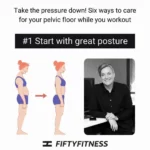
1. Start with great posture
Performing exercises with correct posture is the best starting point to taking care of our pelvic floor muscles.
This applies to exercises done in both standing and seated positions.
Keep your weight evenly spread through both feet if you’re standing, and unlock your knees, like you’re bending them ever so slightly.
If you’re sitting, plant your feet evenly on the floor and distribute your weight through your bottom.
Draw the shoulders back and down to feel like you’re opening your heart to the world.
Tuck the chin in slightly and think like you’re trying to stand or sit a bit taller by elongating your back while maintaining its natural curves.
If you poke your bottom out then tuck your tailbone slightly towards the front, you may feel the real core abdominal muscles (transverse abdominus) tensing slightly between your pelvic bones.
Slouching or otherwise poor posture puts pressure on the pelvic floor muscles, while great posture helps us use them more effectively.

2. Mindful breathing during exercise
The way we breathe during exercise is how we can work with intra-abdominal pressure and look after the pelvic floor.
Movement that causes strain or breath holding puts downward pressure on the pelvic floor and must be avoided.
Paired exercise movements – exertion and reset/setup
Most exercises involve paired movements, technically called the concentric and eccentric phases.
We can give them more intuitive names like exertion phase and reset/setup phase and using these terms makes sense because any exercise we do involves a hard bit followed by an easier bit to return to the starting position before repeating the move.
In a squat, we setup by moving into that squatting position. That’s the easy bit.
The exertion phase is when we return to the standing position.
For a push up the exertion phase is when we push the ground to lift the upper body, the reset is lowering back down.
When to inhale, when to exhale
Always inhale during the setup or reset phase and exhale during the exertion phase of an exercise.
The easiest way to remember this is to make sure we’re breathing out during the hard part of the exercise.
That’s all the way through the hard part too, not just a big puff out at the beginning or end of the exertion phase.
We certainly should not hold our breath during this phase.
It can be confusing
I’ve had lots of clients tell me that matching their breathing with the movements of an exercise can be very confusing.
It certainly gets easier to do this with practice but in the meantime, just breathe and don’t hold your breath.
Static hold exercises like planks and wall sits are more perplexing because there are no phases and the whole exercise is the challenge.
Just keep breathing deeply and evenly when doing these isometric exercises.
I distract myself during static holds by doing pelvic floor contractions as I exhale.
Breathing during exercise – key points
- Never hold your breath or strain during an exercise
- Exhale during the exertion phase (the hard part) of an exercise
- If knowing when to breathe in and when to breathe out during an exercise is confusing, just make sure you keep breathing
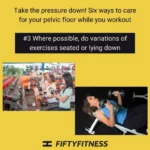
3. Where possible, do variations of exercises seated or lying down
A great way to give your workhorse pelvic floor a break during exercise is to vary the posture.
Many exercises can be performed seated or even lying down on a workout bench or the floor.
Sometimes lying exercises can also be done in a hip bridge.
Hip bridge is great!
While lying on your back, get into a hip bridge by bending your knees to bring your heels close to your bottom.
With hips, knees and ankles aligned, use your powerful glutes to lift your hips off the floor to form a bridge.
This is fantastic for two reasons.
Firstly, you’re giving your pelvic floor a rest from gravity.
Secondly, whenever we contract our glute muscles, the pelvic floor muscles co-contract.

4. Incorporate pelvic floor contractions with other exercises
A strategy I’m working on to get more pelvic floor exercises done is to incorporate them with other exercises.
By throwing in a pelvic floor contraction during the exertion phase and exhalation, the pelvic floor muscles are activated while intra-abdominal pressure is highest.
I do this routinely with squats, but I’ve tried it with just about every exercise I do.
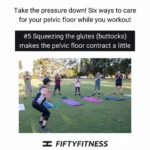
5. Squeezing the glutes (buttocks) makes the pelvic floor contract a little
Consciously squeezing the glutes during any exercise when they’re in use is a great strategy.
Squats, for example, are an exercise I’ve added pelvic floor contractions to.
While I don’t always feel like I’m doing a good pelvic floor contraction during the upward movement, I can always purposely contract my glutes and involve the pelvic floor in any case.
So efficient!
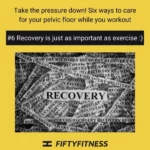
6. Recovery is just as important as exercise
Recovery is a key component of exercise.
It’s during our rest periods that the body adapts to the training we’ve done, when the changes occur that make us fitter and stronger.
If we keep exercising without adequate rest, the body gets fatigued and injured.
The concept applies to the individual parts as well as the entire body system.
We must give the pelvic floor muscles a chance to recover from the stress placed upon them during intense exercise.
A balancing act
Finding the balance between exercising to a level that’s challenging enough to reap the benefits and overcooking yourself can be hard.
You will know you’ve pushed it too far if your exercise is feeling like punishment.
While it should feel a bit hard, the major feelings should be joy and satisfaction.
Including rest days in your overall exercise program and managing your workload to avoid fatigue and injuries will automatically benefit your pelvic floor.
It’s a lot to remember
I know, there are a lot of things to get across here.
Don’t stress yourself out and put pressure on yourself to do everything perfectly straight away.
Focus on one strategy at a time to incorporate them into your routines.
While learning more about pelvic floor health, I’ve incorporated cues and reminders of these strategies into my sessions with clients, helping them build awareness and skills to work with intra-abdominal pressure changes during exercise and protect their pelvic floor muscles.
Learn the 6 strategies from this blog one at a time with my FREE video series
I’ve curated all the information from this blog into a video series so you can learn the strategies gradually.
Here’s how it works.
Every day for 6 days you’ll receive and email from me with a video of each strategy so you can learn them one at a time. On the 7th day I’ll send you an e-booklet with all 6 strategies collated in one handy resource that you’ll have forever.
The video series is ready – click the link below to start learning the 6 strategies now!
https://bit.ly/TakeThePressureDown
Keep in touch
Please reach out to me if anything in this article resonates with you.
You can email me at kate@fiftyfitness.com.au or connect via social media.

Subscribe now
Blog Subscription Form
A blog subscription form, used for the blog page and posts.
"*" indicates required fields